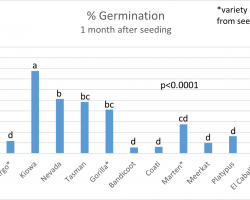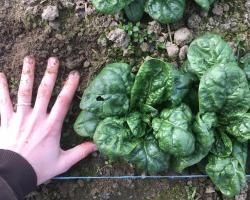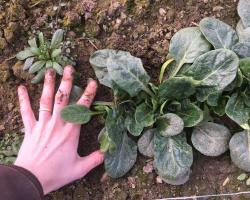Spinach downy mildew has been present in spinach-producing parts of the world since the 1800s. More recently, with the increasing demand for bagged spinach greens, this disease has become increasingly important. Outbreaks of spinach downy mildew have occurred in New England very year since 2014, primarily in the late-fall, winter, and early-spring. Many New England growers plant spinach in valuable high tunnel space for fall, winter, and spring markets—for those growers, spinach downy mildew can pose a significant threat to winter production and income.
Spinach downy mildew is caused by the oomycete pathogen Peronospora effusa (previously called Peronospora farinosa f. sp. spinacea). Like other oomycete pathogens such as late blight and other downy mildews, spinach downy mildew is an aggressive pathogen and it can quickly render a spinach planting unmarketable. This pathogen produces asexual sporangia that emerge from stomata and are dispersed by wind and splashing rain or irrigation water. These sporangia land on other leaves, germinate, and cause new infections. Sporangia require leaf moisture to germinate, and disease development is favored by cool temperatures and high humidity—late-fall and early-spring high or low tunnel environments are often ideal for downy mildew. Fuzzy gray-purple sporulation forms on the undersides of infected leaves when conditions are conducive to disease development. When infected plants are harvested before they start sporulating, the disease can develop in retail bags.
P. effusa can also undergo sexual reproduction—there are two mating types of this pathogen, and if opposite mating types meet within a spinach plant, oospores will be produced. Oospores are thick-walled, long-lived spores that can survive on seed and in soil. Oospores of spinach downy mildew are routinely found on spinach seeds, but researchers are uncertain if growing conditions in the Northeast are conducive to oospore germination—therefore it’s not yet clear what role oospores play in the spinach downy mildew life cycle in the Northeast.
All downy mildew pathogens are highly host-specific. P. effusa can only infect spinach and cannot infect other crops, even crops in the same family such as beets or Swiss chard. Similarly, other downy mildews that affect, for example, cucurbits, basil, lettuce, or brassicas, cannot infect spinach. Additionally, P. effusa is a complicated organism which exists as a suite of many races or strains, and not all races are able to infect all varieties of spinach. There are currently 17 identified spinach downy mildew races. Spinach varieties have different genes that give them resistance to specific downy mildew races. For example, the variety ‘Tasman’ is resistant to races 1-12 and 14-16 but is not resistant to races 13 or 17. Spinach breeders are constantly selecting for and breeding new spinach varieties that carry resistance against the most number of strains and the most recently evolved strains. However, the pathogen evolves quickly. It takes time for breeders and seed producers and distributers to get a new spinach variety to market; in the past, the spinach downy mildew pathogen routinely “broke” new resistance genes before the new resistant varieties even made it onto the market. Resistance to the most recently identified race, race 17, seems to be more robust than resistance to older strains and has held up for several years now.
Spinach downy mildew races are classified by inoculating a set of spinach varieties. The resulting pattern of which varieties develop downy mildew determines the race of the downy mildew isolate. If a specific isolate is determined to be a significant threat to large-scale spinach production areas like California and Arizona, it is given an official race designation. If an isolate doesn’t align with an existing race and doesn’t pose a significant threat, it is designated “novel”. Since 2014, there have been outbreaks of races 12, 14, and 15 as well as several novel strains in the Northeast.
In the winter of 2018-19, the UMass Extension Vegetable Program conducted a trial to evaluate the performance of fifteen spinach varieties in a winter high tunnel growing system. These types of studies are important because almost all spinach varieties are developed for California or Arizona production and when they are released by seed producers, it’s often not known how they will perform in different environments. The trial was conducted in an unheated high tunnel at the UMass Crop Research and Education Farm in South Deerfield, MA. Spinach was seeded by hand on October 26, before the tunnel had been skinned—tunnel plastic was installed on October 31. Plots were 4 feet by 4 feet squares with 5 rows of spinach seeded at 2 inch in-row spacing and 2 seeds per hole, and organized in randomized complete blocks with each variety replicated four times. There were 2 feet of unplanted buffer around each plot. It rained the day after seeding, and because the tunnel was not yet skinned, the seed didn’t have to be manually watered in. After the tunnel was skinned, the trial was irrigated as needed—twice in December and once in March. There was a hard frost immediately after seeding into the uncovered tunnel, which may have affected germination. If anything, the results from this trial show how these varieties perform despite less-than-ideal conditions!
| table 1. downy mildew race resistance of varieties included in the 2018-19 trial | |
|---|---|
| Variety | Resistance |
| Callisto | 1-14, 16, 17 |
| Regor | 1-17 |
| Virgo* | 1-15 |
| Kiowa | 1-17 |
| Nevada | 1-17 |
| Tasman | 1-12, 14-16 |
| Gorilla* | 1-8, 10-15 |
| Bandicoot | 1-16 |
| Coati | 1-15, 17 |
| Marten* | unknown |
| Meerkat | 1-15, 17 |
| Platypus | 1-15, 17 |
| El Caballo* | unknown |
| Fresno* | unknown |
| Bloomsdale | none |
| *no longer available from producer at time of trial | |
The varieties in this trial were all relatively new spinach varieties with the newest resistance packages at the time. By the time the trial had started, the varieties Virgo, Marten, El Caballo, and Fresno were no longer being produced. See Table 1 for the resistance of the varieties in this trial.
There was low downy mildew disease pressure during the winter of 2018-19—there was only one reported local outbreak of spinach downy mildew this winter—so we never observed the disease in the trial. We therefore were not able to collect any data on differences in resistance between the varieties to local spinach downy mildew strains. We rated germination one month after seeding, on November 19. Plot vigor was then rated regularly, on December 18, January 8, 15, and 29, February 5 and 12, and March 1, taking into consideration, stand, plant size, and yellowing. In Figure 2, plot vigor from February 12 only is presented because most varieties were of harvestable size on that date. The spinach was harvested on March 4 (reps A, B, and D) and March 8 (rep C), and plot yields were recorded along with notes about flavor, texture, and ease of harvest.
Of the varieties trialed, five varieties performed equally well in terms plot vigor at harvestable size and harvest weight: Regor, Kiowa, Nevada, Gorilla, and Fresno. Regor and Kiowa had significantly higher germination rates than the other varieties. The plot vigor and harvest weight of Tasman were also equally high, but Tasman had a slightly lower germination rate. Marten had very poor germination but then grew quickly; this variety could have been harvested much earlier than other varieties and the leaves were quite large by the time the other varieties were ready to be harvested. This explains how the variety with the lowest germination rate ended up with the highest harvest weight. Of the highest performing varieties, Gorilla, Marten, and Fresno are no longer produced by seed producers, leaving Regor, Kiowa, Nevada, and Tasman as the best-performing available varieties. Regor, Kiowa, and Nevada all have the most complete and current resistance packages—all are resistant to races 1-17. Tasman is not resistant to race 13.
Several winter spinach growers told us that the demand for local spinach in the winter is so high that they can sell as much as they can produce, regardless of leaf shape, minor flavor or texture differences, or other parameters. We noted some slight differences in flavor and texture between the varieties in this trial, but nothing drastic that would make a variety unmarketable.
The growth habits of the varieties in the trial varied from very upright to very prostrate. Flatter varieties, including Regor, were more difficult to harvest compared to more upright varieties, including Nevada. We seeded the spinach at fairly wide spacing. It’s likely that decreasing the spacing would make it easier to harvest the more prostrate varieties, because the leaves would grow upright against each other. Kiowa and Tasman both had fairly upright growth habits and, despite being grown at fairly wide spacing, formed compact plants.
In March 2019, Jim Correll, a spinach researcher from the University of Arkansas who works with large-scale spinach growers in California and Arizona, visited Massachusetts to teach us about spinach downy mildew and to learn about winter spinach production in New England. Together, we toured several farms growing high tunnel spinach. Some take-home messages on how to improve winter spinach production from Jim’s visit are:
- Plant varieties with the most comprehensive resistance. The downy mildew race that pops up in a given area is often determined by the varieties that are being grown. For example, if several nearby growers all plant Tasman year after year in their tunnels, it’s likely that eventually, race 13 or 17 will pop up in the area because Tasman does not have resistance to either of those races. The fact that we’ve seen races 12, 14, and 15 in the Northeast is probably Photos taken May 1, four months after seeding. Clockwise from top left: Kiowa, Nevada, Tasman, and Regor. Photos: G. Higgins Photos taken February 5, three months after seeding. Clockwise from top left: Kiowa, Nevada, Tasman, and Regor. Photos: G. Higgins 3 not because those are the only races present but because growers are planting varieties that happen to be susceptible to those races. Therefore, planting races that have full 1-17 resistance is the best way to prevent a downy mildew outbreak on your farm.
- Plant several varieties. Regardless of whether you are planting 1-17 varieties or not, plant more than one variety. Novel strains of spinach downy mildew that don’t match any of the 17 races are common, and we can’t predict which varieties a novel strain will be able to infect. With more than one variety planted, it’s less likely that you will lose all of your spinach to a novel strain.
- Take the time to prepare uniform beds. Many winter spinach growers struggle with patchy germination and leaf yellowing in spinach beds. This may be due to inconsistent moisture in the beds—on our farm tours, we observed that wet (and often lower) spots tended to show yellowing, potentially because of nutrient leaching, among other factors. Taking the time to prepare beds that are slightly raised and well-tilled may help reduce inconsistencies in germination, soil moisture content, and fertility.
- Decrease plant spacing. Spinach varieties vary a lot in their growth habits—some are very upright, while others grow very close to the ground. For varieties that grow close to the ground, decreasing plant spacing will make harvesting easier because the plants will prop each other up into more upright positions. Some growers choose to harvest spinach leaf-by-leaf, harvesting older leaves and leaving younger leaves to grow; decreasing plant spacing would likely make harvesting more difficult with this harvest technique.
- It’s possible to grow winter spinach without heat or row covers. It can feel scary to leave a crop in the ground, even in a high tunnel, when temperatures drop to the single digits, but we’ve found that cold-tolerant spinach varieties can survive the cold just fine without supplemental heat or row cover. Twice during the trial, air temperatures dropped below 16°F for three nights in a row—January 21-23 and January 31-February 2. The lowest air temperatures during the trial was 13°F on January 21. Soil temperature at 3” below the soil surface dropped to 32°F during that period. Frost developed on the spinach in our trial several times over the winter but we observed only minimal frost damage in the tunnel. Eliminating the labor costs of dealing with row cover and the cost of heating a tunnel can increase net income from winter spinach production.
Many New England growers direct-seed spinach in high tunnels in the fall, just before main-season field crews are done for the year and harvest just enough spinach to keep a bit on farm stand or farmers market shelves through the winter. For many growers, winter is a time for much-needed rest and planning and it’s nice to not have crops in the ground begging to be harvested. For growers who want to maximize winter profit or just get the most out of valuable high tunnel space, it seems possible to increase winter spinach yields and make production more efficient with fairly minimal effort, including trying some new varieties.
This work was supported in part by USDA-NIFA Extension Implementation Program (EIP) grant funds, Award No. 2017- 70006-27137, and in cooperation with Dr. Jim Correll, University of Arkansas Division of Agriculture.









